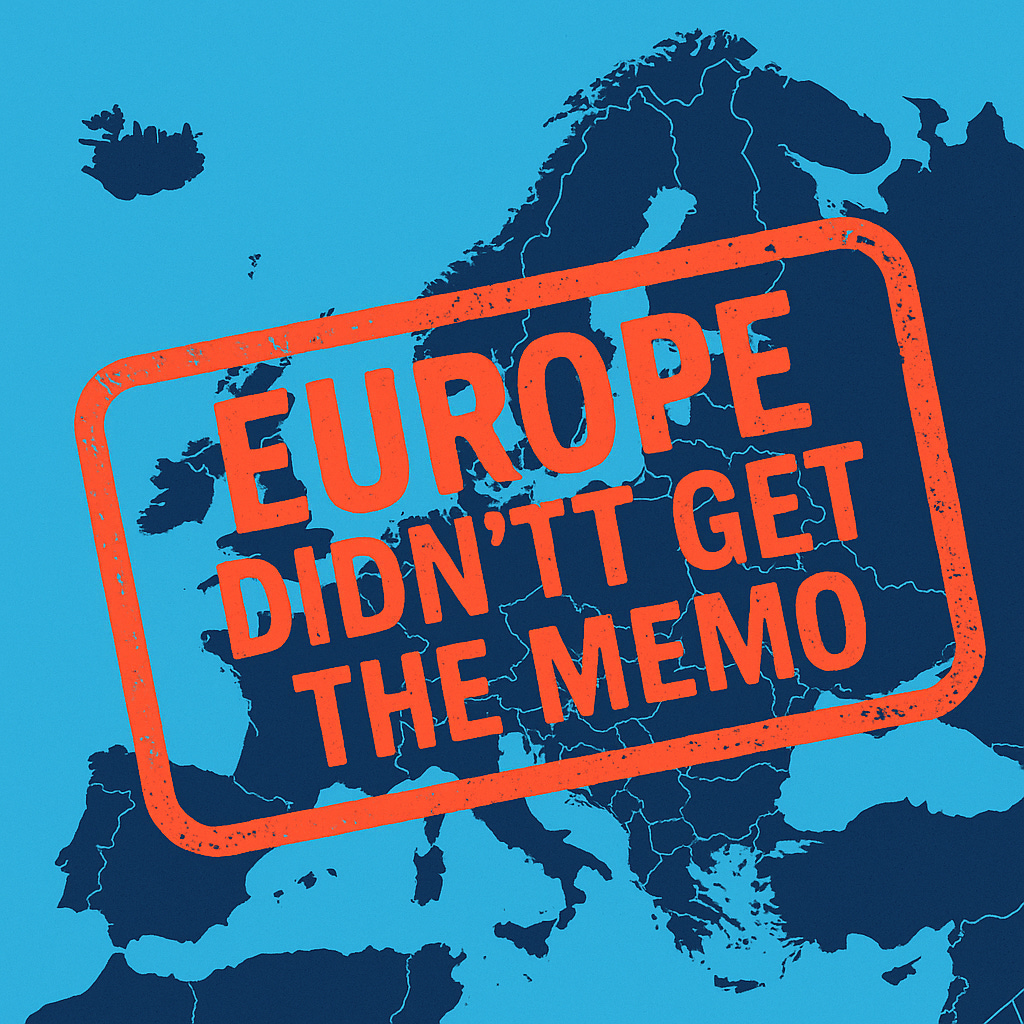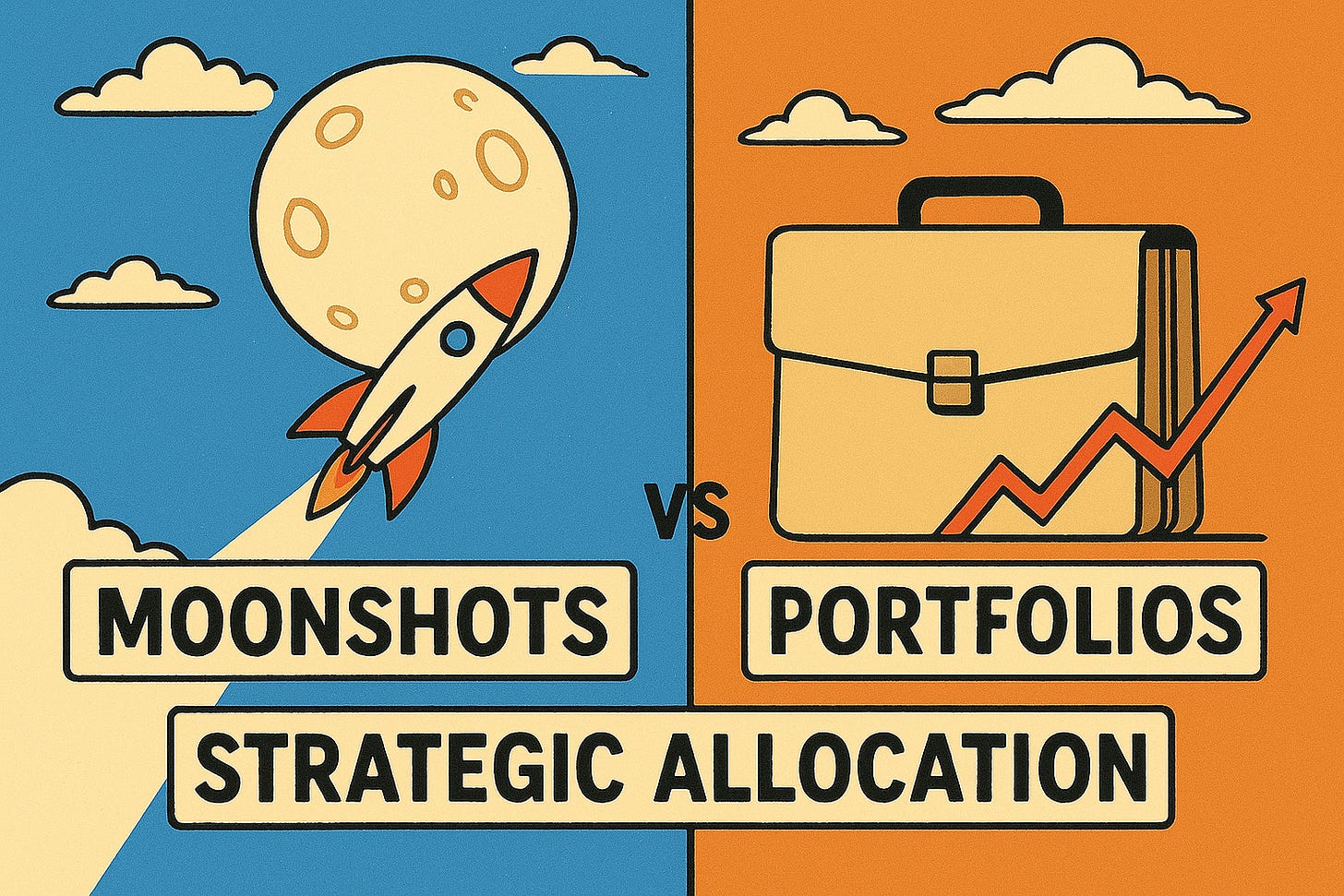Europe Didn’t Get the Memo - and That’s a Good Thing
Q3 2025 was dominated by Anthropic and xAI headlines. But beneath the noise, European founders raised record rounds to build sovereign infrastructure, deeptech and the AI middleware layer that actual
Global venture capital surged to roughly $97 billion in Q3 2025, a 38% year-on-year jump, with nearly half flowing into AI, according to Reuters. Anthropic’s $13 billion Series F alone accounted for roughly 29 percent of the quarter’s funding, while Elon Musk’s xAI raised another $5.3 billion. The United States captured about $60 billion of the total. On the surface, the story seems predictable: the Valley builds the future, the rest watches from the sidelines.
But look a little closer, and a different story starts to emerge.
Europe’s Quiet Outperformance
Zooming in on Europe, the picture looks very different. Venture investment reached €29.2 billion in the first half of 2025, with AI accounting for €10.1 billion - around a third of total deal value. But liquidity hasn’t kept pace with ecosystem growth, adding pressure on LPs and driving more activity in secondaries.
All of this is happening against a backdrop of rapidly shifting capital markets for deeptech and AI globally. Oracle’s 40% share price surge on the back of massive multi-year AI infrastructure contracts signals how hyperscalers are moving from balance sheet to leveraged financing. Meanwhile, humanoid robotics is stretching valuations into rarefied air - Figure raised ~$1 billion at a $39 billion valuation for less than 3% dilution. And in frontier tech, fusion startups have already raised more than $2.6 billion YTD versus $1.6 billion in all of 2024, while IonQ’s market cap has quadrupled over two years, fueling billion-dollar M&A and large follow-on rounds for IQM (€320 million) and Quantinuum ($600 million).
But here’s the twist: on performance, Europe is quietly leading. While Europe still trails the U.S. and Asia in capital deployed, its venture performance is quietly outperforming both regions over 3- and 10-year horizons. Greg Schmitt of MEAG attributed this to a mix of lower entry valuations - thanks to less local capital - and higher exit valuations internationalisation, a classic multiple arbitrage that’s increasingly visible across later-stage infra and AI bets.
This performance advantage rests on a rapidly expanding ecosystem. Over the past decade, European venture capital has exploded in scale. More than €418 billion has been invested in the last five years alone, backing over 3,200 new VC firms and creating more than 350 unicorns. Yet, as Joe Schorge has pointed out, this growth hasn’t been matched by liquidity. European VC has built an enormous stock of assets, but distributions have lagged.
Even Philippe Laffont, founder of Coatue and one of the world’s most prominent tech investors, recently said, “This year, I feel more like it’s the year of the privates” (Economic Club of New York, via WSJ). That shift is exactly where Europe’s strategy lives: deep in the private-market layers where infrastructure, quantum, and middleware play compound quietly.
But Europe clearly didn’t get the memo. Instead of trying to out-Anthropic Anthropic, European founders and investors quietly had one of their most consequential quarters in years - not by playing catch-up, but by building their own playbook: sovereign infrastructure, deeptech ambition, and the unsexy AI plumbing that actually powers enterprises.
Sovereign Infra Goes Loud
“We are building the AI-native infrastructure platform of tomorrow. The physical backbone: the data centres, the GPUs and the software.”
Josh Payne, CEO, Nscale
The loudest signal came from the UK, where Nscale pulled off a $1.1 billion Series B in late September 2025 - the largest Series B in UK and European history, according to the company and described by the Financial Times as one of Europe’s biggest early-stage tech financings.
The round was led by Aker ASA, flanked by NVIDIA, Dell, Nokia, Fidelity Management & Research Company, Point72, Blue Owl (Managed Funds), G Squared and T.Capital (company press release). More than another big AI raise. This was a public-private industrial strategy disguised as a funding announcement. Aker brings Norwegian energy and infrastructure heft. NVIDIA and Dell supply the muscle. Nokia roots it in Europe’s telecom legacy.
Aker CEO Øyvind Eriksen praised Nscale’s “full-stack, GPU-first model.” Dell EMEA president Adrian McDonald framed their investment as “building tailored platforms that drive meaningful progress.” Nokia CEO Justin Hotard (in office since April 2025) declared, “We’re combining our IP and optical networking with their platform.” This is corporates, sovereign funds and global capital forming a European AI backbone.
A few weeks earlier, Finland’s IQM Quantum Computers closed a $320 million (€275 million) Series B, described by Tech.eu as the largest Series B in quantum in Europe and outside the U.S. The round, announced on September 3rd 2025, was led by Ten Eleven Ventures with participation from Tesi, the European Innovation Council Fund, Bayern Kapital, Schwarz Group and others.
“This funding accelerates our roadmap towards error-corrected systems and U.S. expansion,” said Jan Goetz, Co-Founder and Co-CEO. IQM isn’t a research lab; it’s Europe’s deeptech standard-bearer, marrying hard science with industrial scaling in a way few ecosystems outside the U.S. or China can.
In late August, UK-based Paragraf quietly raised a $55 million Series C, led by Mubadala, joined by Amadeus Capital Partners, British Patient Capital, IQ Capital, Parkwalk Advisors, Molten Ventures, Cambridge Enterprise, Martlet Capital, Draper Esprit and Archangel Investors. “This investment is a strong signal of confidence,” said CEO Simon Thomas, “enabling us to expand production of faster, more energy-efficient technologies.”
Paragraf is industrializing graphene electronics - one of those technologies Europe has talked about for a decade but is now finally scaling. Taken together, Nscale, IQM and Paragraf paint a picture that’s impossible to ignore: Europe’s deeptech and infra thesis is no longer theoretical. Dealroom’s European Deep Tech Report 2025 pegged deeptech investment at €15 billion in 2024, roughly a third of all European VC. Q3 2025 shows that capital now concentrating at scale in sovereign infrastructure and industrial technologies.
These moves underscore a broader strategic shift.
Moonshots vs Portfolios: Strategic Allocation
And here’s where the memo really didn’t land: while the U.S. poured tens of billions into a handful of AI labs, Europe built a portfolio. Nearly a third of global VC this quarter went into just two U.S. companies (Anthropic and xAI, Reuters). Europe deployed roughly the same capital volume across infrastructure, deeptech, middleware and logistics - spreading risk strategically, not timidly. This wasn’t about avoiding big swings; it was about building the backbone of the AI economy instead of betting it all on a few moonshots.
Some seasoned voices are already sounding cautionary notes. Bryan Yeo of GIC warned, “There’s a little bit of a hype bubble going on in the early-stage venture space” (Reuters). Manny Roman, CEO of PIMCO, told the Financial Times that “the private markets in their current form haven’t been tested and they will be tested when there’s a recession.” Europe’s diversified allocation looks less like risk aversion and more like strategic insulation against that future stress test.
Franklin Templeton’s private markets team added another layer: “As private market valuations have reset from their lofty 2021 levels, we believe that allocating capital in the coming year looks attractive across much of the private market’s ecosystem.” That’s exactly the terrain Europe is playing on: less speculative froth, more structured compounding.
Policy is reinforcing these private bets. The European Commission has launched a €10 billion public–private fund under its Startup and Scaleup Strategy to back AI, cybersecurity and cleantech, while the €800 billion ReArm initiative is catalysing a surge of aerospace and defence investment across the continent.
European policymakers echoed this at Bits & Pretzels: while growth capital is increasing, almost none of it originates locally - most still comes from U.S. and Asian investors. As Germany’s Minister for Economic Affairs put it, if Europe wants to retain value where it’s created, local growth funding has to catch up.
Pipes vs Models
“Capability means nothing without context. The agents that win understand the work - that’s what we make possible.”
Tuhin Chakraborty, CEO, Mimica
Meanwhile, on the AI application layer, Europe is quietly doubling down on what it does best: enterprise plumbing.
In mid-September, London-born Omnea raised a $50 million Series B, co-led by Insight Partners and Khosla Ventures, with participation from Accel, Point Nine, First Round Capital, Prosus Ventures and LocalGlobe. “Businesses hold a treasure trove of supplier data,” said Ben Freeman, Omnea’s founder. “Our AI unlocks that data.” Khosla Ventures called Omnea “the first full AI supplier relationship management platform,” and Insight’s Jeff Lieberman didn’t mince words: “Of the many players we looked at, Omnea had the happiest customers.”
Just a week later, Mimica followed with a $26.2 million Series B (£19.5 million) led by Paladin Capital Group alongside Khosla Ventures, LGVP and Entrepreneurs First. Paladin’s Nazo Moosa highlighted that Mimica “unlocks the workflow layer at scale… moving to production-ready automation”. Earlier in the month, DRUID AI, founded in Bucharest and now headquartered in New York, secured $31 million Series C led by Cipio Partners, with follow-on participation from Karma Ventures, Hoxton Ventures, Smedvig Capital and TQ Ventures. “This investment is a catalyst to elevate businesses globally through agentic AI,” said CEO Joseph Kim.
“AI investors are navigating peak ambiguity.”
Hemant Taneja, General Catalyst
This “pipes vs models” contrast matters. While the Valley races to build ever-bigger brains, Europe is quietly laying the plumbing that keeps those brains alive. As Hemant Taneja told the Financial Times, AI investors are navigating “peak ambiguity.” When ambiguity reigns, pipes matter more than hype. It’s not as flashy. There’s no model weight count or GPU leaderboard. But in enterprise, logistics, infrastructure and deeptech, these “pipes” define who actually controls value chains. And increasingly, U.S. investors are following that scent. Insight, Khosla, Accel and Prosus aren’t here out of charity - they’re betting on the European operational DNA that quietly runs the world.
As one of our portfolio fund managers put it in their latest quarterly report, it’s about being able to “spot extraordinary founders that aren’t interested in playing in the current AI race, but rather seek to transcend it.”
Climate, Logistics and the Streets
Finally, there’s HIVED, a London-based all-electric parcel delivery network, which raised £31 million ($42 million) Series B in July 2025, led by NordicNinja, joined by Planet A Ventures, Wex VC, Yamato Holdings, Future Back (Bain & Co), Rocketship.vc and Elemental Impact.
“Parcel delivery should feel seamless, not stressful,” said Murvah Iqbal, HIVED’s co-founder. “Most of the industry runs on systems never designed for ecommerce.” NordicNinja’s Tomosaku Sohara described HIVED as “reimagining delivery from the ground up… with technology as the foundation.” It’s a reminder that Europe’s innovation story isn’t confined to labs and data centers—it’s also happening on the streets, where AI meets electrification and logistics.
Who Should Be Paying Attention
For LPs, the signal is clear: the European opportunity isn’t in chasing the next model war. It’s in backing the foundational layers - sovereign infrastructure, quantum, workflow intelligence, climate logistics - that will define value chains for decades. This is where pricing has reset, competition is thinner, and moats can actually be built. At the same time, allocators are increasingly turning to secondaries and structured liquidity as the European market matures, looking for exposure without relying on public exits. As Joe Schorge pointed out at Bits & Pretzels, secondary funds have notched record years one after another and are now firmly on the path to becoming mainstream - spanning company secondaries, strip sales, fund vehicles, and GP stakes.
Behind this lies a structural shift: Europe now has the highest stock of venture-backed tech assets in its history, and even modest turnover of 3-5% represents €13–21 billion of potential secondary volume annually. Secondaries have evolved from a niche into an essential part of Europe’s venture plumbing. For founders, they enable personal de-risking and cap table clean-ups; for VCs, they accelerate DPI and extend runways; and for LPs, they unlock portfolio rebalancing and access to top vintages. And crucially, timing matters: the most attractive entry points increasingly sit between Series B and D, when value is visible but upside remains.
For policymakers, Q3 2025 offers a blueprint: targeted industrial strategy works when it’s paired with bold founders and global capital. Rather than scattergun subsidy programs, Europe’s strategic bets - on compute, deeptech and integration layers - are beginning to compound.
For corporates, the message is equally stark: the strategic advantage won’t come from licensing the next model API; it will come from controlling the pipes. That’s why Dell, Nokia, NVIDIA, Aker and others are already on the cap tables of Europe’s biggest B+ rounds.
The Strategic Turn
While the U.S. concentrated its bets in a few colossal AI labs, Europe spread its firepower across sovereign infrastructure, quantum hardware, graphene electronics, workflow intelligence and climate logistics. SVB’s Global Private Market Trends 2025 reports that half of AI VC and growth deals were in companies based outside North America.
KPMG’s Venture Pulse (Q2 2025) notes that European policymakers are deliberately prioritising capacity building in AI, defence and deeptech as part of their industrial strategies. Academic work like Europe’s AI Imperative argues that Europe’s position between the U.S. and China gives it a unique opening to lead on infrastructure, interoperability and safety - if it keeps its nerve.
S&P Global’s 2025 PE/VC Outlook found that private markets participants are “more optimistic now than a year ago,” even as macro risks remain. That sums up Europe’s Q3 perfectly: confident, but not naive.
Q3 2025 won’t be remembered for Europe producing the next Anthropic. It should be remembered for something quieter but more strategic: Europe finally acting like a bloc that knows what it’s good at. Less noise. More signal. Europe didn’t get the memo - and thank God for that. Because the memo was about chasing moonshots. Europe is busy building the world they’ll need to fly through.





